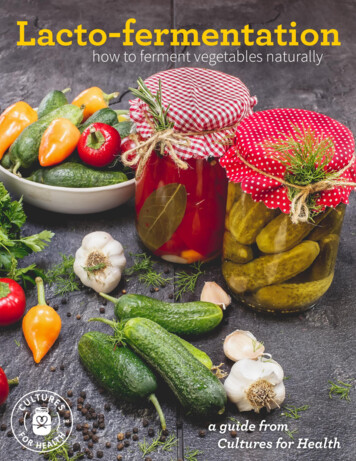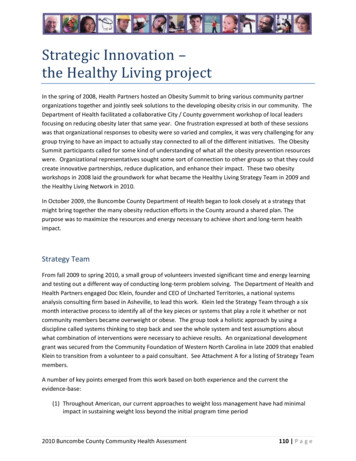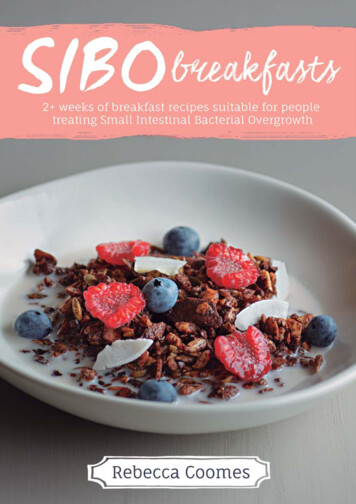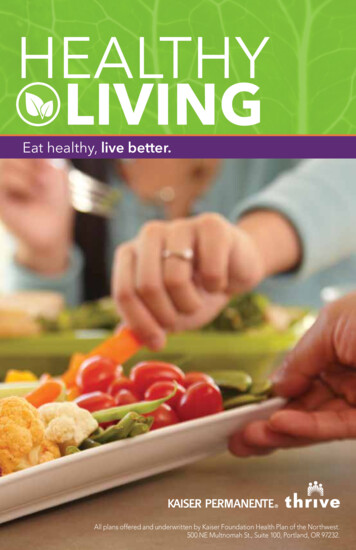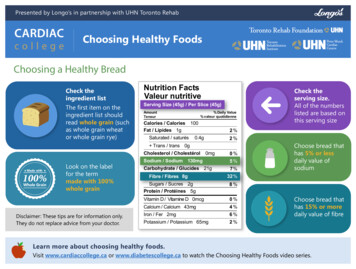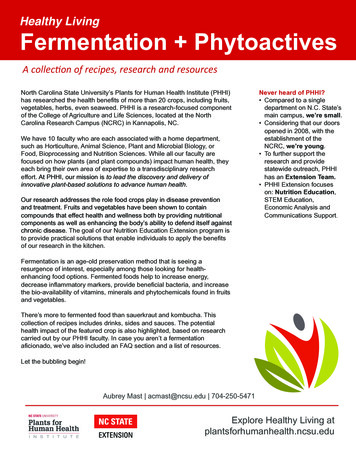
Transcription
Healthy LivingFermentation esNorth Carolina State University’s Plants for Human Health Institute (PHHI)has researched the health benefits of more than 20 crops, including fruits,vegetables, herbs, even seaweed. PHHI is a research-focused componentof the College of Agriculture and Life Sciences, located at the NorthCarolina Research Campus (NCRC) in Kannapolis, NC.We have 10 faculty who are each associated with a home department,such as Horticulture, Animal Science, Plant and Microbial Biology, orFood, Bioprocessing and Nutrition Sciences. While all our faculty arefocused on how plants (and plant compounds) impact human health, theyeach bring their own area of expertise to a transdisciplinary researcheffort. At PHHI, our mission is to lead the discovery and delivery ofinnovative plant-based solutions to advance human health.Our research addresses the role food crops play in disease preventionand treatment. Fruits and vegetables have been shown to containcompounds that effect health and wellness both by providing nutritionalcomponents as well as enhancing the body’s ability to defend itself againstchronic disease. The goal of our Nutrition Education Extension program isto provide practical solutions that enable individuals to apply the benefitsof our research in the kitchen.Never heard of PHHI? Compared to a singledepartment on N.C. State’smain campus, we’re small. Considering that our doorsopened in 2008, with theestablishment of theNCRC, we’re young. To further support theresearch and providestatewide outreach, PHHIhas an Extension Team. PHHI Extension focuseson: Nutrition Education,STEM Education,Economic Analysis andCommunications Support.Fermentation is an age-old preservation method that is seeing aresurgence of interest, especially among those looking for healthenhancing food options. Fermented foods help to increase energy,decrease inflammatory markers, provide beneficial bacteria, and increasethe bio-availability of vitamins, minerals and phytochemicals found in fruitsand vegetables.There’s more to fermented food than sauerkraut and kombucha. Thiscollection of recipes includes drinks, sides and sauces. The potentialhealth impact of the featured crop is also highlighted, based on researchcarried out by our PHHI faculty. In case you aren’t a fermentationaficionado, we’ve also included an FAQ section and a list of resources.Let the bubbling begin!Aubrey Mast acmast@ncsu.edu 704-250-5471Explore Healthy Living atplantsforhumanhealth.ncsu.edu
Fermentation es
Healthy LivingFermentation PhytoactivesTABLEOFCONTENTSContentPageOverview 3Frequently Asked Questions .4-5Beverages Beet Kvass .6 Blackberry Soda .6 Ginger Bug .7 Quinoa Rejuvelac 7 Sweet Potato Fly .8Side Dishes Black Bean Hummus. .9 Bubbly Berries . . 9 Dilly Carrots. .10 Fermented Mashed Potatoes .10 Mango Sauce .11 Seaweed Sauerkraut .11 Spiced Winter Squash .12 Sundried Tomato & Walnut Cheese . 13Resources . . .14Aubrey Mast acmast@ncsu.edu 704-250-5471Explore Healthy Living atplantsforhumanhealth.ncsu.edu
Healthy LivingFermentation PhytoactivesWhat is fermentation?Lactic acid bacteria is naturally occurring, covering the surface of allplant foods, and also found within plant cells. In the presence of a brinesolution and an anaerobic environment, lactic-acid bacteria digestsstarches, sugars, fats, and minerals of a plant, converting them intoforms of energy.This metabolic process, aided by microbial bacteria, changes a rawfood to a fermented food, which is more easily digestible for humans. Thefermented foods are rich in probiotics, which feed beneficial bacteria inthe human body. Lactic acid bacteria have been recognized for more than100 years for the ability to restore, and replenish the microbiome in thedigestive tract.During the process of fermentation, carbon dioxide is created, a byproduct of the lactic acid bacteria. This carbon dioxide is visible asfermentation occurs with the appearance of bubbles. Oxygen worksagainst lactic acid bacteria, so the less oxygen there is, the better thefermentation results.What are phytoactives?Phytonutrients are chemical compounds that naturally occur in plants.They are found in fruits, vegetables, legumes, nuts, and teas and arewidely recognized as health-promoting. Phytonutrients, sometimesinterchangeably referred to as phytoactives or phytochemicals, are“bioactive” compounds, meaning that they are biologically active,absorbed or transformed by the chemical processes that are constantlyoccurring in the human body.While phytonutrients are not essential to the body, like vitamins andminerals are, they may help prevent disease and keep the body workingproperly. More than 25,000 phytonutrients have been identified in plants,but here are a few that you may have heard of: carotenoids, flavonoids,resveratrol, and glucosinolates. If those names seems foreign, then takenote, because chances are good that as the research becomes moreclear, those phytonutrients (and others) will become part of a healthyvocabulary.OVERVIEWBeta- ‐caroteneCitrullineAnthocyaninsFermentation PhytoactivesThe process of fermentation increases the bioavailability of thephytonutrients found naturally in fruits and vegetables, making fermentedfoods and beverages incredibly healthful. Not only are they packed full ofbeneficial probiotics, they help with digestion, energy, and nutrientutilization.Aubrey Mast acmast@ncsu.edu 704-250-5471-3-Explore Healthy Living atplantsforhumanhealth.ncsu.edu
Healthy LivingFermentation PhytoactivesFAQSFrequently Asked QuestionsHow much is a serving size?Fermented foods are a rich source of probiotics. When adding fermentedfoods into your diet, it is best to start small. Beverages: 2-4 ounces, daily Fruits and Vegetables: 2 tablespoons, dailyDo I need a special container?No. The beauty of fermenting fruits and vegetables is that it is a trueexperiment. One can ferment in a bowl, jar, bottle or any other glasscontainer. Glass is the preferred choice because it is non-porous. Othermaterials can leach chemicals from the container into the ferment. Sincefermentation is an acidic process, there in an increased potential forleaching. There are specialized pieces of equipment that may aid thefermentation process, but they are not required.BasicSupplyList strainerWeightsWhat is a starter culture?Whey, probiotic capsules or liquid from a previously fermented food act asa “starter” to assist the fermentation process. These starter culturesprovide the microorganisms (such as bacteria or fungi, e.g. yeast) thatactivate, or start, the fermentation process.What is whey and where can I find it?Whey is a protein found in milk. It can easily be found in a container ofyogurt or kefir purchased from the grocery store. You may have noticedthat when you first open a container of yogurt, there is usually a clearliquid on top of the yogurt. This is the whey, so simply pour it off and usethat as your starter. You can also collect the whey from kefir or yogurt bycovering it with a coffee filter, securing the filter with a tightly fitting rubberband and flip it upside down over a bowl to catch the whey as it dripsthrough the filter.What does it mean to “feed the ferment?”Feeding the ferment with sugar or salt (depending on the recipe)stimulates the bacterial growth to ensure the continuation of thefermentation process.Aubrey Mast acmast@ncsu.edu 704-250-5471-4-Explore Healthy Living atplantsforhumanhealth.ncsu.edu
Healthy LivingFermentation PhytoactivesFAQSFrequently Asked QuestionsWhy is cheesecloth often used to cover the fermentation mixture?Cheesecloth is used to keep fruit flies, insects or any other particles fromentering the ferment. A napkin, paper towel or hand towel will serve thesame purpose.How do I ensure produce stays submerged?Keeping fermentations submerged can be done in several ways. Iffermenting in a glass bowl, you can place a glass plate over the fermentas a weight. You can also purchase fermenting weights that are made ofglass or ceramics, and these may be an easier option for jars. You canalso place large cabbage or collard green leaves on top of any fermentand weigh the leaves down with a clean rock, a filled jar of water, orsimply pushing it down daily with your hand. Submersion is important toensure an anaerobic environment to prevent mold growth.Yikes! My ferment is molding. What happened?Mold growth can happen for a whole host of reasons. A few commoncauses in fermentation are: it’s too warm, contamination (mold spores) onthe food being fermented or in the jar, not adequately submerged allowingfor exposure to air.The rule of thumb is to scrape the mold off, including the top layer of theferment. Smell or taste the ferment and if it seems “off,” add it to yourcompost pile and start again. Fermentation is all about experimentation.Don’t let one bad experience sour your interest.What are a few of the basic rules for successful fermentation? Ferment in a glass container and use wooden utensils; never plastic orstainless steel. Keep ferments completely submerged under brines by using a weight,plate or lid. Check ferments daily. Never place a ferment in direct sunlight. Do not place different fermented items next to each other. The flavorscan co-mingle.Aubrey Mast acmast@ncsu.edu 704-250-5471-5-Explore Healthy Living atplantsforhumanhealth.ncsu.edu
Healthy LivingFermentation PhytoactivesBEVERAGESBeet Kvassª 2-4 beetsª ¼ cup whey* or juice from sauerkrautª 1 tbsp. sea salt or Himalayan saltª filtered water* See FAQsDifficulty:Container: ½-gallon JarDays to ferment: 2Wash beets, peel and chop into small cubes. Place beets in half-gallonglass jar. Add whey/sauerkraut juice and salt. Fill jar with filtered water.Cover with cheesecloth and leave on the counter at room temperature fortwo days to ferment, then refrigerate. Consume as desired.Blackberry Sodaª 4 cups blackberriesª ½ cup honey or sugarª 1 tbsp. whey or starter culture*Difficulty:Container: 32 oz. bottleDays to ferment: 2-3Cover blackberries in a pot with water. Simmer for 30 minutes, then cool.Strain out blackberries, using a sieve to push out remaining juice whilecapturing seeds. Add honey or sugar and the whey or culture, and stiruntil dissolved. Pour juice into a bottle, tighten the lid and let sit for two tothree days at room temperature. Keep refrigerated once desiredeffervescence is reached.Some of our research looked at the color compounds (anthocyaninsand proanthocyanidins) found in blackberries. These compounds mayhelp manage glucose levels in the blood, aiding in diabetes management.BlackberryPhytoacCves: Anthocyanins ProanthocyanidinsHealthTarget DiabetesAubrey Mast acmast@ncsu.edu 704-250-5471-6-Explore Healthy Living atplantsforhumanhealth.ncsu.edu
Healthy LivingFermentation PhytoactivesBEVERAGESGinger Bugª 1-2 fresh ginger rootsª ½ cup white sugarª 2 cups filtered water* See FAQsDifficulty:Container: Quart jarDays to ferment: 5Freshly grate 2-3 tbsp. of ginger root. Place the grated ginger in a quartsize glass jar and add an equal amount of white sugar (2-3 tbsp.). Using awooden spoon, stir in 2 cups of filtered water and lightly cover withcheesecloth. For the next five days, stir the mixture at least once dailyand add 1 tbsp. of freshly grated ginger root and 1 tbsp. of sugar eachday.Once the ginger bug has fermented (5 days), it can be used to createfermented sodas or drinks. Use a ratio of ¼ cup ginger bug per quart ofsweetened herbal mixtures (for ginger ale or root beer) or diluted fruitjuice (for fruit-flavored sodas). To feed the ferment*, start the recipe over.Difficulty:Container: ½-gallon jarDays to ferment: 5Quinoa Rejuvelacª ½ cup quinoaª 4 cups water, separatedSoak quinoa in 1 cup water for eight hours. Pour off water and rinse twoto three times. Add 3 cups of water to rinsed quinoa and let sit for twodays. Gently stir twice a day for two more days until the quinoa hassprouted. Strain the liquid into a bottle, discarding quinoa. Refrigerate anddrink.Quinoa leachate (water that the quinoa was soaked in) may be a way tokeep the health benefits of quinoa’s phytochemicals while preservingquinoa’s macronutrients providing anti-diabetic therapeutic benefits.Aubrey Mast acmast@ncsu.edu 704-250-5471-7-Explore Healthy Living atplantsforhumanhealth.ncsu.edu
Healthy LivingFermentation PhytoactivesBEVERAGESSweet Potato Flyª 2 large sweet potatoesª 1 gallon waterª 2 cups sugarª ½ cup whey or starter culture*ª 2 lemons, zested and juicedª 2 tsp. cinnamonª 1 tsp. nutmegª ½ tsp. ginger* See FAQsDifficulty:Container: ½-gallon jarDays to ferment: 3-5Grate the sweet potatoes. Add other ingredients, stir and cover. Allow toferment for three to five days. Strain through a sieve and bottle thefermented liquid. Store in the refrigerator up to one month.Sweet potatoes possess the bioactive compounds carotenoids,anthocyanins, phenolic acids, flavonoids, and vitamin C. Thesephenolics are responsible for antioxidant and free radical scavenging,which reduces oxidative stress.Orange- tpurple- ‐andyellow- ey Mast acmast@ncsu.edu 704-250-5471-8-Explore Healthy Living atplantsforhumanhealth.ncsu.edu
Healthy LivingFermentation PhytoactivesSIDEDISHESBlack Bean Hummusª 1½ cups cooked and drained black beansª ¼ cup lemon juiceª 2 garlic cloves, mincedª 2 tsp. sea saltª ¼ cup whey or starter culture*ª 1 tsp. cuminª 1 tsp. cayenneª 4 tbsp. water* See FAQsDifficulty:Container: Quart jarDays to ferment: 3Blend all ingredients in a food processor until a paste forms. Addwater as needed for desired consistency. Transfer to a jar andtighten lid. Allow to sit at room temperature for three days. Servewith fresh vegetables or crackers. Store in refrigerator for up toone week.The polyphenols (antioxidant phytochemical that has the tendencyto prevent or neutralize free radical damage) found in black beanswere researched for their ability to reduce inflammatory markersassociated with cardiovascular disease and cancer risks.Bubbly Berriesª 2 cups mixed berriesª 2 tbsp. honeyª ½ tsp. starter culture or whey*ª ¼ tsp. sea saltDifficulty:Container: Quart jarDays to ferment: 1-2Mix together all ingredients. Make sure that berries are submergedunder liquid. Use a weight* to keep them submerged if necessary.Cover with lid and let sit for one to two days. Move to refrigeratorand enjoy within two months.Blueberries and blackberries have been researched for theirphytoactive compounds: anthocyanins and proanthocyanidins.Research indicates that berries can reduce overall inflammatorymarkers affecting the nervous, immune and digestive system.Aubrey Mast acmast@ncsu.edu 704-250-5471-9-Explore Healthy Living atplantsforhumanhealth.ncsu.edu
Healthy LivingFermentation PhytoactivesSIDEDISHESDilly Carrotsª 6 medium carrots, cut into sticksª 1 tbsp. starter culture*ª 1 tbsp. sea saltª 1 tsp. dried dillª 3 garlic clovesª Water* See FAQsDifficulty:Container: Quart jarDays to ferment: 4-7Place all ingredients into a quart glass jar. Cover with water. Swirl gentlyand add a weight to submerge ingredients. Cover with cheesecloth andallow to ferment for 4 to 7 days at room temperature. Once flavor desiredis reached, cover tightly and move to the refrigerator.Part of the research involved in the mapping of the carrot genome,looked at the role of beta-carotene and carotenoids in decreasing therisk of disease, particularly certain cancers and eye disease.Fermented Mashed Potatoesª 4 cups cooked and peeled potatoesª 2 cups plain yogurt or kefirª 2 tbsp. rosemaryª 1 tbsp. sea saltDifficulty:Container: Glass bowlDays to ferment: 2Mash cooked potatoes in a large bowl. Blend in yogurt, rosemary and seasalt. Cover with a piece of cheesecloth and secure a rubber band aroundthe bowl. Let sit at room temperature for two days then refrigerate. Servewarm, but not hot.Our research suggests that the protease inhibitor in potato helps makeone feel full longer, reducing food intake, which could be an effectivestrategy in weight loss and managing glucose intolerance, a specialinterest in diabetics.Purple potatoes offer the added benefit of additional phytonutrients.Aubrey Mast acmast@ncsu.edu 704-250-5471- 10 -Explore Healthy Living atplantsforhumanhealth.ncsu.edu
Healthy LivingFermentation PhytoactivesSIDEDISHESMango Sauceª 1 mangoª ½ cup sugarª 1 cup filtered waterª ½ cup kefir or whey*ª 1 tsp. lemon zest* See FAQsDifficulty:Container: Quart jarDays to ferment: 3-5Roughly chop the mangoes. Put the mangoes into a large container andcover with sugar. Stir with a wooden spoon and allow to sit at roomtemperature for about an hour, softening the mangoes and releasingjuices. Pour water, kefir or whey, and lemon zest over mangoes. Stirvigorously, twice a day for 3-5 days. Cover with cheesecloth and allow toferment. When the fruit has risen to the surface and there is bubbling, it istime to prepare the sauce. Strain the liquid, setting it aside for anotherferment (this can be a starter culture)*. Transfer mango solids to blenderand pulse to desired sauce consistency. Store in an airtight container inthe refrigerator. Serve with oatmeal, on crepes or drizzled on yogurt.The results of our research showed mango’s ability to change gutinflammation through modulation of the gut microbiota, under thecircumstances of a high fat diet.Seaweed Sauerkrautª 1 medium head of cabbage, thinly chopped or shreddedª ¼ cup dulse seaweed tornª 2 tbsp. sea saltDifficulty:Container: 1-gallon jarDays to ferment: 30Toss cabbage, salt and dulse seaweed together. Knead the cabbage till itis limp and has released its juice. Pack into a jar and use a weight tomake sure the cabbage is covered by liquid that the cabbage released.Allow to sit at room temperature for at least one month. Refrigerate oncepreferred flavor is reached.Our research showed that brown seaweeds (kelps) have the potential todelay the absorption of digested carbohydrates. When incorporated intothe diet, seaweed has the potential to reduce the impact of oxidativedamage associated with obesity, diabetes, and cardiovascular disease.Aubrey Mast acmast@ncsu.edu 704-250-5471- 11 -Explore Healthy Living atplantsforhumanhealth.ncsu.edu
Healthy LivingFermentation PhytoactivesSIDEDISHESSpiced Winter Squashª 1 winter squashª 2 tbsp. sea saltª 2 cinnamon sticksª 10 whole clovesª 2-inch knob ginger rootDifficulty:Container: 1-gallon jarDays to ferment: 7Peel the winter squash, reserving the peelings for the ferment. Cutsquash in half and discard the seeds. Chop squash into one-inch cubesand place cubes in a one-gallon glass jar. Add peelings and remainingingredients to jar and cover with water. Shake to mix thoroughly. Use aweight to ensure squash stays beneath water. Cover with cheeseclothand allow to ferment at room temperature for one week. Once fermented,move to the refrigerator. Spoon out to serve as a snack, as a saladtopping or add into a rice pilaf dish.While many vegetables loose nutritional value after harvested from theplant, research is underway looking at how Vitamin A actually increasesin winter squash during storage. Vitamin A plays a role in geneexpression, vision, maintenance of skin, immune defenses, growth ofbones, and the development of cells.Aubrey Mast acmast@ncsu.edu 704-250-5471- 12 -Explore Healthy Living atplantsforhumanhealth.ncsu.edu
Healthy LivingFermentation PhytoactivesSIDEDISHESSundried Tomato & Walnut Cheeseª 2 cups raw walnutsª ¼ cup whey or starter culture*ª 2 tbsp. lemon juiceª ½ ounce sun-dried tomatoesª 1 tbsp. orange juiceª 1 tsp. sea salt* See FAQsSoak walnuts for at least 12 hours. Blend soaked walnuts, whey andlemon juice in a food processor until smooth. Cover with cheesecloth andlet ferment at room temperature for 12 hours. Place the sun-driedtomatoes in 1 cup of water for approximately one hour to reconstitute. Afterwalnut paste has fermented, use a food processor to blend walnut pastewith drained sun-dried tomatoes, orange juice and sea salt. Serveimmediately or store in the refrigerator for up to five days.Difficulty:Container: Quart jarDays to ferment: 1Walnutssoakedovernight,onrightOur research showed that walnut extract is able to kill a variety of differentcancer cells. The research highlights that walnuts have multiple avenuesin which they may slow the progression of cancer cells.Aubrey Mast acmast@ncsu.edu 704-250-5471- 13 -Explore Healthy Living atplantsforhumanhealth.ncsu.edu
Healthy LivingFermentation PhytoactivesRESOURCESOnline ResourcesFermentation, University of California Cooperative .pdfWant to Ferment Vegetables?, Clemson University Cooperative aring and Canning Fermented Foods and Pickled Vegetables, USDAhttp://nchfp.uga.edu/publications/usda/GUIDE06 HomeCan rev0715.pdfMicrobialFoods.org: Digesting the science of fermented foodshttp://microbialfoods.orgBooksThe Art of Fermentation, Sandor KatzMastering Fermentation, Mary KarlinReal Food Fermentation, Alex LewinFermented Vegetables, Kirsten K. Shockey and Christopher ShockeyWild Fermentation, Sandor KatzAubrey Mast acmast@ncsu.edu 704-250-5471- 14 -Explore Healthy Living atplantsforhumanhealth.ncsu.edu
Healthy Living Explore Healthy Living at plantsforhumanhealth.ncsu.edu North Carolina State University’s Plants for Human Health Institute (PHHI) has researched the health benefits of more t
